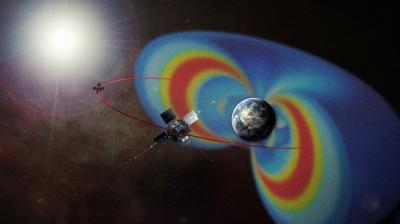In 1958, scientists discovered two gigantic belts of radiation around Earth that have provided tantalizing mysteries to researchers ever since. One unsolved mystery: What accelerates particles in the belts to almost the speed of light? The best answer is that some kind of electromagnetic wave coursing through the belts pushes the particles along, not unlike a wave in the ocean providing a ride for a surfer.
NASA's twin Van Allen Probes launched in August 2012 to help differentiate between the many waves that might be doing the work. Now, observations from the mission show in unprecedented resolution that more low frequency waves are present than generally accounted for, offering one possibility for what's speeding the particles up so fast. The results were published in Nature Communications on Nov. 19, 2013.
"These observations show some of the most beautiful examples of the low frequency waves that we've seen," said David Sibeck, mission scientist for the Van Allen Probes at NASA's Goddard Space Flight Center in Greenbelt, Md. "It's important to include all these different types of waves into our models to best understand what drives the complex radiation belts."
The radiation belts are indeed complex, changing shape and size in response to incoming energy and particles from the sun. In extreme cases of such space weather, nearby satellites can be engulfed by the belts, potentially charging the spacecraft or even short-circuiting internal electronics. Better understanding of the processes inside the belts can ultimately help protect orbiting spacecraft from damage.
"Essentially near-Earth space is filled with a basic magnetic field which can be perturbed by a modest solar wind from a very typical star," said Ian Mann, first author on the paper and a space scientist at the University of Alberta in Canada. "When compared with the much more exotic astrophysical objects out in the universe, Earth's system doesn't initially look like it should accelerate particles up to such incredible speeds. But something is happening right above our heads that is a very efficient, planetary-scale accelerator, and scientists have been trying to understand this ever since the belts were first discovered."

The twin Van Allen Probes circle through the radiation belts surrounding Earth to help scientists study what processes can accelerate particles there near to the speed of light.
(Photo Credit: NASA)
This accelerator is being observed with unprecedented detail by the Van Allen Probes. The results have important implications for understanding cosmic particle acceleration throughout the universe, at locations too far away to reach with spacecraft.
Mann searched through the Van Allen Probe observations for examples of how low frequency waves might be affecting the particle speeds. The belts are made of a gas of very energetic charged particles known as plasma. Plasmas are governed by a host of electromagnetic laws of physics that we rarely experience on Earth, including the presence of a collection of different types of plasma waves, many of which could contribute to the particle acceleration. In general, particles in the radiation belts have three natural courses of movement: gyrating around the magnetic fields in tight spirals, bouncing back and forth along the magnetic field lines, and circling around and around the entire Earth in orbits with periods of only a few minutes. Different plasma waves might have the correct frequency to strongly interact with any one of these types of motion.
Mann and his colleagues found swaths of speeding particles that bore the signature of having been accelerated by low frequency waves, called Ultra-low frequency or ULF waves. These global scale waves are perfectly matched to push the particles along on their orbit the way one might push a child on a playground merry-go-round at exactly the right moment with exactly the right speed. Such a well-timed, synchronized push is the way particles are sped up in so-called synchrotron particle accelerators, which physicists build for particle experiments on Earth.
"People have considered that this acceleration process might be present," said Mann. "But we haven't been able to see it clearly. Now we know that we just didn't have the right resolution to see it."
The Van Allen Probes data also showed that the acceleration mechanism acts much faster than standard models of ULF wave interactions, information that could adjust scientists' understanding of belt dynamics. Mann plans to incorporate increased numbers of the ULF waves into his models and see how this matches up to observations of what's going on in the radiation belts. Such comparisons help fine-tune models of the belts until they become as accurate as possible. As the Van Allen Probes continue to orbit through the radiation belts, they are gathering information about a host of other waves and particle movements as well, all of which go toward improving models of this region.
"The instruments on the Van Allen Probes were designed to provide data with unprecedented completeness and fidelity within the heart of Earth's radiation belts," said Barry Mauk, the Van Allen Probes project scientist at the Johns Hopkins University Applied Physics Laboratory in Laurel, Md. "It is immensely satisfying to see those capabilities used, as has been done in this new work, to achieve new understandings about how Earth's space environment operates."
Source: NASA/Goddard Space Flight Center